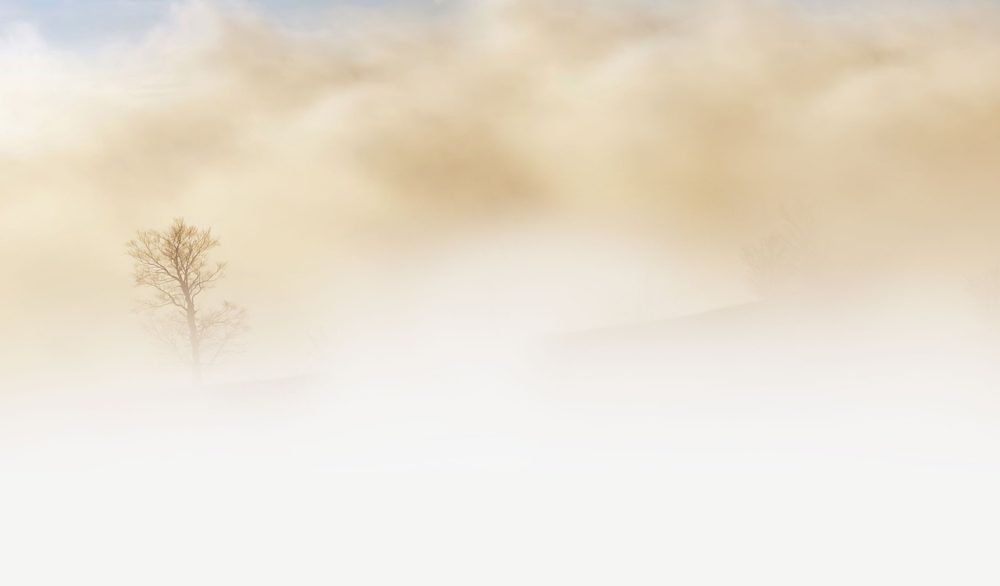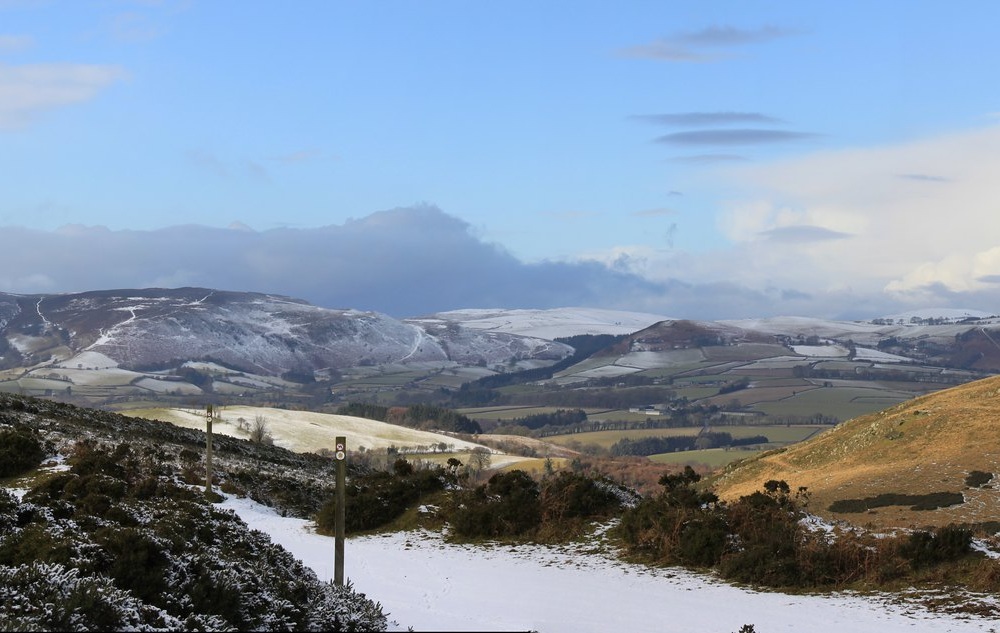Letter from Hergest Ridge

James Roberts
It’s been high season for mist and fog here in the Welsh Marches. Every year we get a few weeks where it never clears.
It used to be a major source of stress to me. I worked a long distance commute away, and the drive home at night with only 10 metres of visibility was nerve wracking.
These days I barely use my car and mist has become a companion on the path. Once it was an obscuration, now it’s a collection of luxurious veils.
Yesterday I walked along the green lane which climbs Hergest Ridge towards Gladestry and looks across the valleys to Ireland Moor.
Hergest Ridge straddles the Welsh and English border.
Resonances
Hergest is a name with many resonances. One of the manuscripts of the Mabinogion was once owned by the Vaughan family at Hergest Court near Knighton, and is known as the Red Book of Hergest.
Hergest Ridge is the name of an album by the multi-instrumentalist Mike Oldfield which followed his hugely successful Tubular Bells.
On the ridge the view changes by the second, fields and woods appearing and vanishing, changing shape and tone.
One minute the mist was a uniform curtain with only the faintest grey shapes of the terrain beyond. A minute later it shifted, broke up, its edges feathering over pine trees to let the sun stain the peaks orange. Then, down it came again and the world whitened.
The most useful thing I was taught at art college was how to stare at a blank sheet of paper.
We were asked to scrunch the sheet up, smooth the creases out and pin it to the wall. Then we had to spend three days drawing and painting it. At first I thought this was an act of sadism on the part of my bored tutor, particularly when he stood behind me, stared at my drawing then burst out laughing before moving on to his next victim.
One question he repeatedly asked me was “What colour is a bus?” To which I answered, “Red”. He’d tut, shake his head and then ask his next question “Does it hurt when you think?” It did. I took this last question as a compliment because he at least recognised I had something to think with, when all of my previous teachers had not. Later I found out that he was a brilliant painter who eventually retired to Cornwall to study the light.
I hope he’s still doing that, though it would mean he’s about 110. I have a lot to thank him for. He woke me up.
When you spend three days staring at a blank sheet of paper you realise that everything visible changes all the time. This is objective – light shifts throughout the day, shadows and colours are cast by surroundings which are also in a process of change.
A red bus is never, ever red. This was the first in a chain of discoveries.
Perception
I’ve come to learn that this objectivity, rich source though it is, still only accounts for a fraction of our perception. The rest is subjective.
What you perceive in one moment has transformed or receded or even inverted in the next. The subconscious projects onto the conscious. What we see is half real – half dream.
A blank piece of paper can hold all the colours in the universe and everything you can perceive or imagine. A blank piece of paper becomes Shakespeare’s The Tempest, Bronte’s Wuthering Heights, Rembrandt’s The Raising of Lazarus, Dickinson’s Wild nights – wild nights!
Mist is a vast sheet of paper with constantly changing translucencies: vellum – parchment – washi. You can project the world onto it and you can see the world through it, two worlds interacting, overlapping and combining as it shifts.
It obscures and reveals, adds substance then removes it, lightens, darkens, whitens, silvers.
I swear when I used to commute home on December nights I saw ghosts in the fog – running deer, wolves, huge birds. I swear also that I saw lights, flicking on high up, inscribing white lines across the sky, then blinking out.
Many fairy tales were composed by night travellers navigating in fog.
Malformation
I’m learning the potter’s art. I’ve possibly covered the basics now, which means I can centre a lump of clay on the wheel, then lift and shape it into something resembling a vessel. Some of these vessels are aesthetically pleasing. Others are not.
The latter make me feel sorry for the clay, which thereafter lives no longer malleably, but fixed as a malformation for centuries (I can’t bring myself to smash them up as this seems like an even more terrible destiny for the clay).
However, I do feel like I’m getting better as a maker. So now I’m moving on to the creation of glazes.
Ash glazes are where my interest lies, particularly Japanese Nuka glazes, which are pale, subtle, myriad and beautiful. These were originally created from the ash formed by the burning of rice hulls.
There is a residue of silica in the hulls which is a constituent of glass. When burned again at very high temperatures the ash turns translucent to varying degrees, pale grey-white with hints of colour depending on what it’s coating.
Just like mist it breaks and feathers over uneven surfaces, runs into gulleys, crawls over edges. The ash can be mixed with other materials, from plants and trees, or other clays and powdered stones.
Each mix creates a different finish and they can be combined in endless ways. I’ve read about potters who only use ash from deadfall in certain woods, or in specific areas within those woods to get the effects they want.
This place-specific aesthetic appeals to me enormously and I’m eager to begin experimenting. I’m envisioning glazes made from materials on the hills which echo the mist that gathers there at certain times – grey-green refractions through pine trees, red-orange tinges from almost spent beech leaves.
Mist, like glaze, is an envelopment. Though it can fill fields, valleys, counties, even countries it can also coat the minutiae of places – every pebble and blade of grass, every pinule on a frond of bracken, every hyphae on a patch of lichen, glazing it all with a Nuka sheen.

In this place the mist is filled with golden plovers, which sounds like a line from a fairy tale, but it’s true.
They’re the most agile of birds, streamlined for high speed. They flock in echelons high up, then swing down and skim the edges of the bracken. The flock breaks apart, then regroups.
The birds are dark above, pale below and as they change direction their binary switches like code: light|dark, light|dark. I don’t know why they love the mist but they always seem to be around when it’s at its thickest.
I hear their calls first, a faint peep, then their wings as they arrow past just overhead. They rise above the mist, into the blue, then plunge back down like seabirds diving for food. I’ll admit that the only form of intimidation I’ve ever inflicted on wild creatures was to run at a roosting flock of plovers, forcing them to rise and flow around me (please note – this is a practice I’ve since given up).
Reductive
Walking in mist can be a reductive experience if you’re not careful. You can lose a dimension, make the world stand up on its edge and present itself as a sheet of paper.
Golden plovers are the antidote. They invert this perception, adding the dimension of time to the three-dimensional world. They rush into your perception and, as you try to hold onto it, they disappear elsewhere, into the future, which you have to reach into to catch up and see them again.
You anticipate, experience, anticipate again. They stitch the mist with time. I’m making the most of it.
Support our Nation today
For the price of a cup of coffee a month you can help us create an independent, not-for-profit, national news service for the people of Wales, by the people of Wales.




